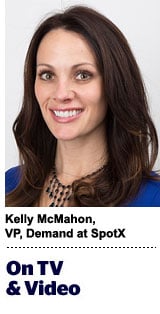 “On TV And Video” is a column exploring opportunities and challenges in programmatic TV and video.
“On TV And Video” is a column exploring opportunities and challenges in programmatic TV and video.
Today’s column is written by Kelly McMahon, vice president of demand at SpotX.
Viewability is now the No. 1 KPI among all online video media buyers, according to eMarketer, a sign that the industry is evolving past CTR and completed streams as indicators of success. As measurement practices continue to improve, buyer expectations are moving beyond viewability, and publishers are scrambling to adjust.
In recent months, there’s been a noticeable shift in buying behavior, with many brands and agencies tightening the screws on viewability requirements. This sudden shift is forcing publishers to direct resources toward improving viewability scores or face the threat of unsold inventory.
For now, the majority of buyers outside of Group M use the MRC standard, where 50% of the video in view for at least two seconds of play is defined as a viewable impression. Expectations vary, ranging from 40% to 100% of impressions bought per campaign must meet the MRC standard. A benchmark of around 70% of impressions meeting the standard is realistic, according to the IAB, with anything higher considered impractical, due simply to the nature in which digital content is consumed. Currently, many advertisers mandate at least 50% of their buys meet the standard, but many are now moving the needle up as pressure for greater viewability builds.
Group M’s stringent, self-imposed standard – 100% of the video player in view and audible to 50% of completion for 50% of impressions – has been instrumental in this change of mindset. MOAT, the first MRC-accredited vendor for viewability measurement, puts the industry benchmark at 56.2% of impressions sold in Q2 2015 meeting the MRC standard according to internal data it has shared with its partners. Only 21.6% met Group M’s standard. As buyers become more demanding, publishers will be forced to evolve beyond these numbers.
The industry has seen evolutions in buying standards before. The viewability evolution will be a balancing act for publishers involving new ad units, sales approaches and other considerations, such as player size, reach and other new standards.
Necessity: The Mother Of Innovation
Viewability’s renewed push has invigorated a round of innovation in the market. I expect it to turbo-charge the shift to mobile video, which has lagged behind the rate at which media consumption has shifted. In the absence of industrywide measurement standards for mobile, comScore has deployed a mobile vCE measurement product that classifies mobile app inventory as 100% viewable.
Additionally, platforms are developing their own standard for deeming mobile inventory as viewable. For example, TubeMogul considers impressions from certified broadcast-quality premium partners as viewable once the 25% completion point is reached. I expect mobile video spend to rapidly increase this year to fulfill buyer demand for viewable placements.
For pre-roll inventory, the basic laws of supply and demand will see publishers adjust their pricing schedules. Prices for highly viewable inventory will inevitably go up; there’s less of it and demand is rising. To cater to this increased demand, publishers can create or participate in curated marketplaces of high-performing inventory.
These marketplaces are similar to private marketplaces but are created around inventory that meets certain advertiser requirements, such as a viewability rates, audiences, devices or websites. Performance is tightly monitored to ensure all buyer KPIs are met, and new supply sources are continually added to increase fill rates on high-performing inventory.
The Pull Of Programmatic
The developing environment is one where transparency and insight into inventory performance and buyer behavior become even more important. This will elevate the importance of programmatic platforms and measurement analytics even more.
The pressure on publishers to optimize their inventory will see them turn to programmatic. Publishers may need to change their page layout, remove below-the-fold placements or increase their player size to improve their viewability ratings.
Hardline standards, such as Group M’s mandate or AVOC (audible and viewable on completion) aren’t the end point for the viewability evolution. Feedback in the market suggests buyers that adopt these standards are having a difficult time getting partners to meet them, but continue to press on. Other buyers are focused on finding the best way to incorporate viewability into all media plans, and recognize industrywide issues, such as measurement discrepancies and buying environments, when developing their strategy.
However, as technology continues to improve, standards will inevitably evolve. It wasn’t long ago that the market transacted on clicks, using CTR to determine inventory value. With viewability, a proactive, mixed-methods approach is needed to ensure supply meets buyer needs, while delivering campaigns in safe and engaging environments.
Follow SpotX (@SpotXchange) and AdExchanger (@adexchanger) on Twitter.










